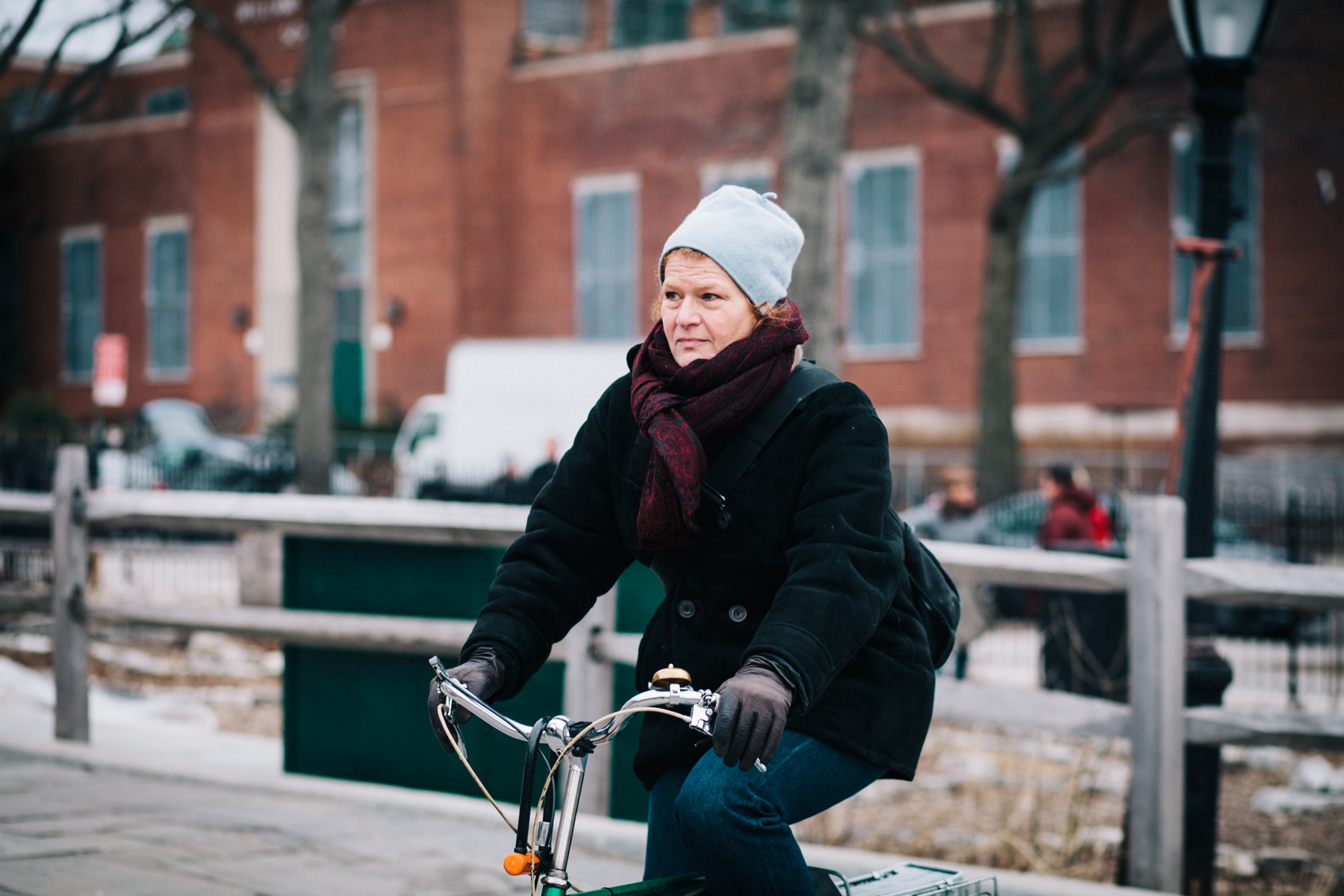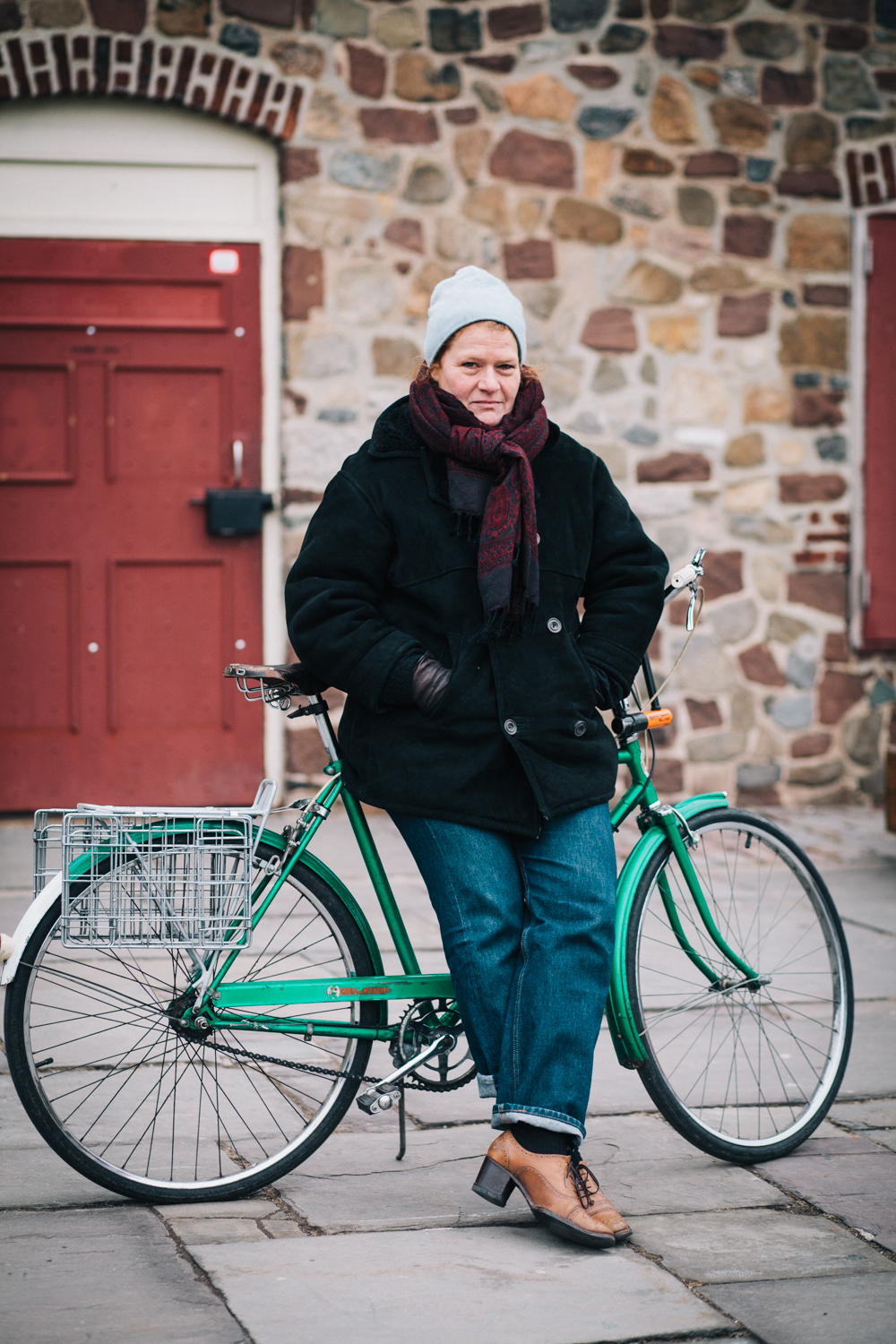March 28, 2014
Bike New Yorker #6: Jeanne Hilary
We talked to the founder of Bicycle Utopia about her organization’s upcoming exhibition at the Old Stone House in Brooklyn, riding cruiser bikes during the winter in Chicago, and why New York is (obviously) the place to be.
Interview and photographs by Sam Polcer. You can see more of his bike portraits at Preferred Mode.
First things first: What is Bicycle Utopia?
Bicycle Utopia is a media project about New York City from a bicycling perspective.
How did it get started?
I’ve worked in media for a long time. I got really interested in how media was changing, right around the time that blogs started. The Internet was finally able to convey images to people. I was based in Paris, with a medium-sized international career working for government agencies, magazines, advertising agencies, and design firms, mostly on lifestyle or urban planning issues. I was working on different kinds of projects that had to do with cities all around the world for about 20 years, shooting photos and developing stories for magazines. And as media started to change, I felt that the more interesting thing was not dropping into Rwanda for a week or Afghanistan for two weeks to work on these really major issues—after I came here I realized that the thing that’s so great about New York City is that you don’t have to get on an airplane to visit the entire world. It’s already here. You can work on all the same issues and just use a subway car or a bike—and not an airplane—to get around. When I started working commercially as a photographer in Paris, I was living on this street where we’d just listen to car horns honking all night long. That’s just psychologically debilitating. The traffic was just so bad in Paris. One of the first projects that I worked on was about transportation and traffic. That’s how I got this urban planning specialization. So I’ve been really interested and aware in how transportation intersects with lots of other issues in cities for a really long time. And then I saw bike share come to Paris and I watched it instantly transform the city in ways I could never have imagined. It was so fantastic. Even just the cars driving slower, with those little noisy motors. You could have a conversation without screaming—that in itself just changes how you feel about being out and about. I was riding my bike one day here in New York, and I had just found out that bike share was starting here. My original idea for Bicycle Utopia was for it to be a completely organic and natural thing. It’s been really exciting figuring out how to make something where people can come together and share their experiences about living in New York City and biking in New York City and just create a place where people can meet each other and exchange perspectives.
When did you get interested in biking?
I’m originally from Chicago, where public transportation is really not that great. If you go inland from the lake, even a mile, you just can’t get around without a car—and I just didn’t want to buy one. I was hardly ever there. I was just basically stopping in to pick up equipment, develop film and leave. So I said, “Let me see if I can get by with just a bike.” That’s when I became a year ‘round biker, because that worked out really well.
Year ‘round in Chicago, huh?
Year ‘round in Chicago.
That must’ve been something.
[Laughs] I had this great bike. That was in the middle of the mountain bike craze. Everyone had a mountain bike and it was all about biking on trails. I tried one, and I thought, “This is just constant work, staying on this bike.” It wasn’t for me, because I’m lazy. In the same shop, there was this hilarious Schwinn copy of a cruiser, like a ‘50s cruiser. It was kind of like sitting in the back seat of a Cadillac that you had to pedal. So that’s the bike that I bought. People gave me the strangest looks. But the great thing with those cruisers is that with those fat tires, you can ride on anything—so I could ride all year ‘round with the snow. It just made no difference.
What was the first step toward creating Bicycle Utopia?
When I got the idea for it, the first thing I did was to apprentice as a bike mechanic at the bike shop in my neighborhood.
Which one was that?
Bicycle Station [on Park Ave. in Brooklyn].
What was that like?
It was really great. Mostly what I did was change about a million flat tires.
Probably the most useful mechanical skill to have as a cyclist in New York City. Do you change your own flats?
It depends on how I’m dressed.
How long did your stint as a mechanic last?
I did that in the winter of 2011, and then I started Bicycle Utopia the following spring.
Bicycle Utopia publishes a zine. Where is it distributed?
In bike shops and bookstores, and now also in museum shops and a few places that just ask for it.
Are you pleased with it?
Yeah. It’s really exciting to make a little magazine. There’s a second issue and now we’re working on the third. The second issue is a bike excursion on Museum Mile. The third is a bike excursion in Brooklyn.
What does it cover in Brooklyn?
The focus of Bicycle Utopia is art and culture, destinations and then places to eat and drink and things like that. There are some really interesting museums in Brooklyn, in addition to the Brooklyn Museum. And then, because Bicycle Utopia is doing this exhibition in the Old Stone House, there’ll be a special map focusing on Dutch history in Brooklyn.
Can you tell me about this exhibition?
Originally, the idea was to have a photo contest where anyone could enter. It was sort of an opportunity to get a feel for the diversity of New York’s cycling community, for all the different ways that people use bicycles in the city. We did that for the first time last year and when we saw the entries… first of all, this is New York City, so the level of quality was really high for everything that was entered… but we also saw that a lot of the photography was kind of limited. It looked like a lot of it was sort of inspired by the photography you see in ads and in bicycle magazines. We wanted to open it up, to try to create a situation where people could be encouraged to be more creative. So I thought we’ll have an exhibition and we’ll invite some artists as well as people who enter a competition. Bicycle Utopia keeps evolving as people get more involved in it. We think about how, from the feedback that were getting, we can make Bicycle Utopia more useful, compelling, entertaining, or exciting for people.







